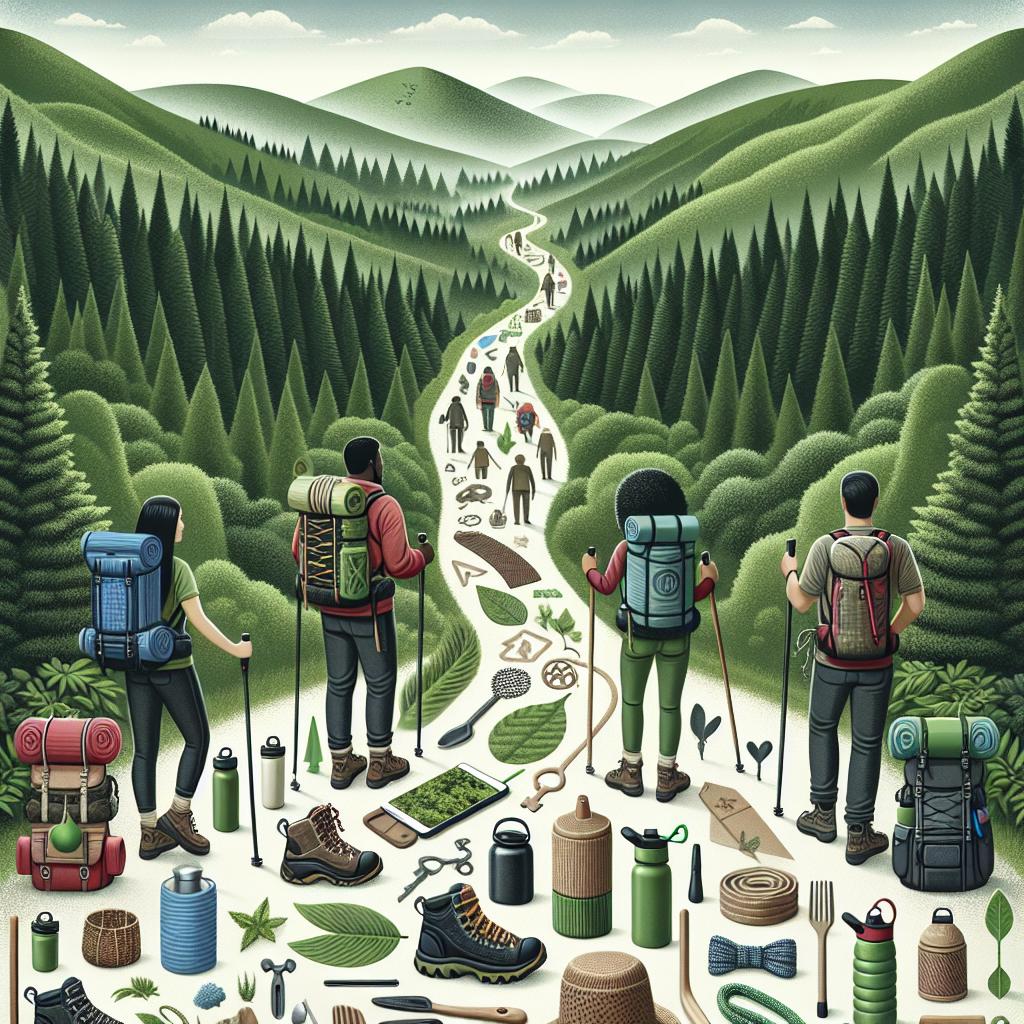Amidst the whispering winds and the gentle rustle of leaves, the Smoky Mountains stand as a timeless testament to nature’s grandeur.A sanctuary for flora, fauna, and curious wanderers alike, these mist-shrouded peaks beckon thousands each year with the promise of breathtaking vistas and serendipitous discoveries. Yet, as footfalls multiply upon ancient trails, the delicate dance between exploration and preservation becomes ever more critical. How then, can one traverse this living tapestry without leaving an indelible mark? Join us as we delve into the best ways to minimize your impact while hiking in the Smoky Mountains, ensuring that this treasured wilderness continues to enchant adventurers for generations to come.
Leave No Footprint: Embrace the Principles of Leave No Trace
- Plan Ahead and Prepare: Before setting foot on the trails of the lush smoky Mountains, ensure that you’ve done your homework. Research the trails, check the weather, and know the regulations of the area. Be prepared to pack out all trash, leftover food, and even small organic waste that doesn’t naturally belong in the ecosystem.By understanding and planning, you reduce the likelihood of causing damage due to unexpected decisions.
- Travel and Camp on Durable Surfaces: Stick to existing trails and campsites to avoid damaging fragile ecosystems. Opt for sleeping on rock, sand, or dry grass rather than lush vegetation. If you must camp off designated sites, ensure your spot is at least 200 feet from lakes and streams to protect the water sources. This practice helps maintain the natural beauty for future adventurers.
| Principle | Benefit |
|---|---|
| Leave What You Find | Preserves the natural and cultural history |
| Respect Wildlife | Maintains the safety of both animals and humans |
| Be Considerate of Other visitors | Enhances everyone’s outdoor experience |

Nature’s Pantry: Sustainable Snacking for the Conscious Hiker
As you journey through the Smoky Mountains, embracing Mother Nature’s fluctuations becomes an adventure on its own. When it comes to snacking, embrace the abundance of nature by opting for sustainable options. Trail mixes with dried fruits, nuts, and seeds not only provide energy but also reduce packaging waste, especially if you prepare them yourself. To lessen your carbon footprint, source locally-made snacks or consider dehydrating your own fruits at home. Reusable silicone bags are an excellent option for storing these snacks safely and securely, making single-use plastics a thing of the past.
Here’s a comparison of eco-pleasant and traditional snack packaging:
| Packaging Material | Eco-friendly? | Reusability |
|---|---|---|
| Plastic Bag | No | Single-use |
| Silicone Bag | Yes | Multiple-use |
| Parchment Paper | Yes | Compostable |
your trail etiquette can also include embracing the Leave No Trace principles. Bringing along a lightweight, collapsible bag for waste ensures that no wrapper, peel, or leftover is left behind. This way, you contribute to preserving the untouched beauty of the landscape. Consider snacks that leave minimal residue; for instance, choose apples over oranges to avoid bulky peels. Encourage group gatherings by proposing a shared snack potluck, where everyone contributes something homemade, creating a communal and environmentally mindful snack spread. By choosing sustainable snack methods and remaining conscious of your impact, the connection with nature becomes genuinely rewarding.

Trail Treads: Eco-Friendly Gear Choices for the Eco-Conscious Adventurer
Venturing through the lush landscapes of the Smoky Mountains offers not only breathtaking vistas but also an opportunity to make conscientious decisions about the gear we choose. Reducing your environmental footprint on these trails starts with opting for sustainable gear choices. Look for items manufactured with recycled materials or those that are biodegradable. Prioritize products with minimal packaging and ensure that any packaging can be recycled or reused. Additionally,backpacks and clothing made from organic cotton or hemp are great eco-friendly alternatives to traditional materials. When given a choice, consider brands that adhere to Fair Trade practices or are part of the 1% for the Planet initiative, as these often reflect a commitment to both environmental and social obligation.
While on your trek, it’s not just about what you carry, but also how you interact with the surroundings. Here are some simple actions to follow:
- Stick to designated trails to reduce erosion and protect fragile habitats.
- Ensure all waste is packed out; bring along a reusable bag for any trash.
- Opt for reusable food containers and water bottles, avoiding single-use plastics.
- Practice Leave No Trace principles by ensuring campsites and picnic areas are left pristine.
| Eco-Friendly Gear | Key Feature |
|---|---|
| Solar Lantern | Rechargeable with sunshine |
| Bamboo Trekking Poles | Lightweight and sustainable |
| Recycled material Tent | Repurposed polyester from plastic bottles |

wildlife Watch: Observing Animals with Respect and Responsibility
- Stay on Marked Trails: Venturing off the paths may be tempting, but sticking to designated trails helps lessen environmental wear and tear. Not only does this protect fragile ecosystems, but it also minimizes animal disturbance, allowing wildlife to thrive unhampered. Respect the route, as each path is designed to traverse through the terrain with the least impact.
- Observe from a Safe Distance: Carry binoculars or a camera with a zoom lens to enjoy the wildlife without encroaching on their space. This not only ensures the safety of the animals but also your own. Remaining silent and still, you’ll witness natural behaviors rather than actions triggered by stress or fear. This quiet observation reduces the risk of startling animals and disrupting their natural routine.
| Action | Impact |
|---|---|
| Leave No Trace | Reduces pollution and protects wildlife habitats |
| Use Eco-friendly Gear | Decreases chemical runoff and litter |
Q&A
Q&A: Best Ways to minimize Your Impact While Hiking in the Smoky Mountains
Q1: Why is it crucial to minimize our impact while hiking in the Smoky Mountains?
A1: The Great Smoky Mountains are a natural treasure, teeming with diverse ecosystems and wildlife. Minimizing our impact preserves these landscapes for future generations, protects delicate habitats, and ensures that the trails and surroundings remain pristine for all to enjoy.
Q2: What are some basic principles of Leave no Trace that hikers shoudl follow?
A2: Leave No Trace principles include planning ahead and preparing, traveling on durable surfaces, disposing of waste properly, leaving what you find, respecting wildlife, and being considerate of other visitors. By following these guidelines, hikers can considerably reduce their ecological footprint.
Q3: How can hikers effectively plan ahead for their trip?
A3: Effective planning involves checking trail conditions, weather forecasts, and park regulations. Equipping yourself with a map, understanding your physical limits, and packing necessary supplies like water, snacks, and clothing layers are crucial steps to ensure a safe and low-impact hike.
Q4: What are some tips for staying on durable surfaces during a hike?
A4: To protect vegetation and prevent erosion, stick to established trails and walk single file in the middle of the path. In areas without trails, opt for walking on rock, gravel, or dry grasses to minimize your footprint.
Q5: How can waste disposal be managed during a hike?
A5: The mantra “Pack it in, pack it out” is vital. Carry all trash, leftover food, and personal items back with you. Bio-degradable waste like apple cores should not be left behind as they can harm wildlife and disrupt natural processes.
Q6: Are there specific ways hikers should interact with wildlife in the Smoky Mountains?
A6: Observing wildlife from a distance is key. Avoid feeding animals, as this can make them dependent and potentially aggressive. Use binoculars or a camera zoom to capture moments without disturbing the creatures or altering their natural behaviors.
Q7: What should hikers know about campfires in the Smoky Mountains?
A7: Campfires can leave lasting impacts, so they should only be built in designated areas with existing fire rings. Hikers should use a stove for cooking and ensure all fires are completely extinguished before leaving, using water to drown embers and ashes until cool to the touch.Q8: How can hikers be considerate of other visitors in the Smoky Mountains?
A8: Sharing trails harmoniously involves yielding to uphill hikers, keeping noise to a minimum, and allowing faster hikers and groups to pass. Kindness and respect for others’ outdoor experiences enrich everyone’s visit to these majestic mountains.
By adopting these mindful practices, hikers contribute to the conservation of the Smoky Mountains, ensuring the stunning beauty and ecological richness remain intact for all who tread its trails.
Future Outlook
As the misty veils of the Smoky Mountains dissolve into the horizon, they leave behind an echo of nature’s quiet resilience—a gentle reminder of our shared responsibility to protect these ancient woods. By embracing sustainable practices, we not only preserve the richness of this stunning terrain for future adventurers but also enrich our own experiences, finding profound connections with the earth beneath our boots. So, as the sun gives way to shadows and the trails begin to fade from view, let us tread softly, leaving nothing but whispers of gratitude on the wind, and carry with us a promise—to walk with care, wherever the journey may lead. Safe travels, fellow hikers, and may your paths always find wildflowers beneath a canopy of stars.

